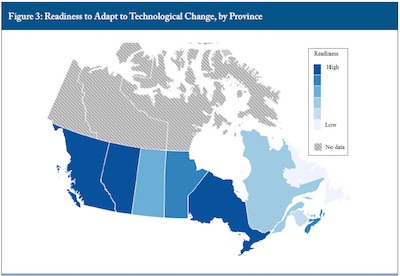C.D. Howe institute Releases Report on Impact of Automation on Labour Markets

January 26, 2018
Provinces with more economic diversification or a concentration of workers in areas that are not very susceptible to automation appear to be better situated for technological change than others, according to a new report from the C.D. Howe Institute. In “Risk and Readiness: The Impact of Automation on Provincial Labour Markets,” author Rosalie Wyonch assesses in each province the risk workers face of automation against the readiness of workers to adapt to technological change.
“Throughout history, technological change has helped lift people out of squalor and poverty, raised standards of living and improved well-being,” states Wyonch. “However, it can also be disruptive, rendering specific occupations and skills obsolete, unsettling economic structures and contributing to unemployment and economic uncertainty.”
Since provinces vary significantly in industrial and labour market structure, each faces different challenges with respect to automation and technology. “High-skill workers are less likely to be automated; moreover, if the past is any guide, the labour market’s demand for skills is likely to continue to increase,” says the author.
“In principle, says Wyonch, “occupations with high skills requirements, where humans still outperform computers, are impossible to automate. Such occupations generally require adaptability to novel situations and problems or involve social components as a key function… Occupations that require low levels of adaptation in the tasks performed and do not require subtle human interactions — for example, bookkeepers, motor vehicle assemblers and service station attendants — are easier to automate.”
In this context, the Wyonch finds that workers in New Brunswick, Newfoundland and Labrador and Saskatchewan are the most susceptible to disruption due to technological change, while those in Ontario, British Columbia and Alberta face the least risk of labour market disruption due to technological change.
To help provinces mitigate the impacts of technological change, Wyonch finds that there is room for public policy to moderate the effect of technological change on the labour market, primarily in two different ways.
1. Provinces facing a lower risk of disruption might be able to leverage existing policies and expand educational or unemployment support where necessary, while those that face a higher risk of labour market disruption might require a broader approach.
2. Governments should continue to adapt existing policies to support workers displaced by technology. For example, Ottawa has leveraged the existing flexibility of the employment insurance program to ensure that workers can return to school without losing their eligibility, and Ontario has expanded access to its Student Assistance Program to mature students.
Differences in the composition of employment and skills levels across the country highlight priority areas that provincial governments should consider in developing education and employment policy responses to adapt to current and future technological change. “Disruption as a result of technological change is not a uniform process, so the policies to tackle it similarly should not be uniform, but should take into account each region’s strengths and weaknesses,” concludes Wyonch. Read the full commentary: https://www.cdhowe.org/public-policy-research/risk-and-readiness-impact-automation-provincial-labour-markets
Image source: Rosalie Wyonch, based on her research and analysis.











